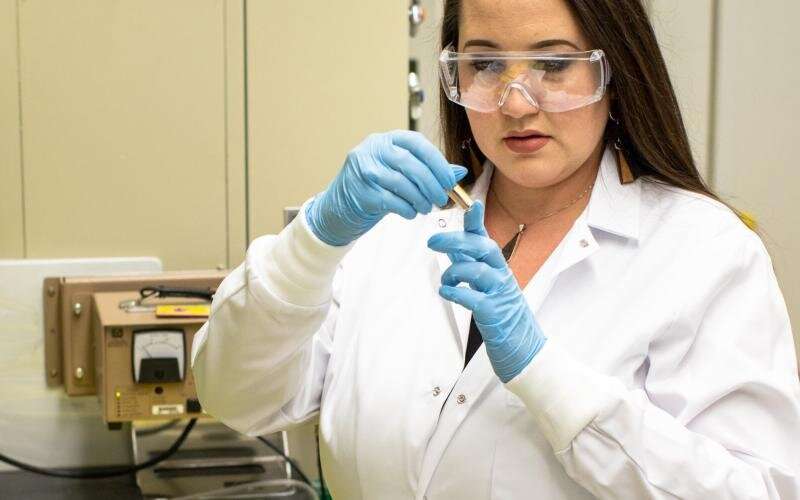This article has been reviewed according to Science X's editorial process and policies. Editors have highlighted the following attributes while ensuring the content's credibility:
fact-checked
peer-reviewed publication
trusted source
proofread
Recent discoveries in phases of uranium oxide advance nuclear nonproliferation

The word "exotic" may not spark thoughts of uranium, but Tyler Spano's investigations of exotic phases of uranium are bringing new knowledge to the nuclear nonproliferation industry.
Spano, a nuclear security scientist at the Department of Energy's Oak Ridge National Laboratory, and her colleagues examined four previously understudied phases of uranium oxide: beta (β-), delta (δ-), epsilon UO3 (ε-UO3) and beta U3O8 (β-U3O8). Each phase has a unique fingerprint that can reveal when something out of the ordinary happened to lead to its creation, helping organizations such as the International Atomic Energy Agency investigate unintended mistakes or blatant misuse of nuclear material.
"There are still unanswered questions, and we are trying to clarify these long-standing questions in literature," said Spano.
Many uranium oxide phases were identified decades ago but had remained loosely understood. The α phase of U3O8, for example, is common, but the β phase is formed under unusual conditions.
Spano focused on the little-known world of uranium oxide phases during her postdoctoral work at ORNL. To her knowledge, no one was working on identifying β, δ, or ε phases, she said. "I focused on these three because they're more exotic." Her findings for β-UO3, δ-UO3 and ε-UO3 , have recently been published. In collaboration with Andrew Miskowiec, group leader for Materials and Chemistry at ORNL, Spano also helped to publish, for the first time, the Raman spectrum of β-U3O8.
While many scientists may be interested in uranium oxide phases, conducting experiments with radiological material requires special precautions and dedicated instrumentation for materials analysis—areas in which ORNL excels. The uranium oxides are common byproducts of uranium processing; this knowledge will help the nonproliferation community develop better tools to understand these materials.
Spano and her colleagues used several analytical methods to observe uranium oxides under different conditions. X-ray diffraction helped them identify the chemical phase of materials. Optical vibrational spectroscopic techniques, such as Raman and infrared, enabled them to observe the chemical structure on shorter length scales, which can be used to identify small quantities of these materials.
"The way UO3 moves through the exotic phases is a little unusual," said Miskowiec. "My team is working on the foundational science to be able to identify these materials if we observe them in the real world and to understand the unusual conditions that led to how they were formed."
The discoveries from this research also support science beyond national security missions. Specifically, the structure of ε-UO3 is of interest for novel reprocessing methods being investigated elsewhere at ORNL and internationally. The detailed knowledge of the structure of this phase is useful in understanding the material's physical properties and performing reaction rate measurements.
Miskowiec's team will continue to explore new ways to catalog materials used in the nuclear fuel cycle. For example, the mysterious amorphous phase of UO3 doesn't have long-range crystallographic order. As a result, the structure can't be examined using X-ray diffraction, but information can still be obtained from the Raman spectrum.
"Some of these compounds are made from specific processes, which gives us a very specific piece of information," said Miskowiec. "It's not only important to identify the compound, but also to have an understanding of its formation conditions."
More information: Tyler L. Spano et al, Computationally Guided Investigation of the Optical Spectra of Pure β-UO3, Inorganic Chemistry (2020). DOI: 10.1021/acs.inorgchem.0c01279
Tyler L. Spano et al, Unexpected features in the optical vibrational spectra of δ-UO3, Frontiers in Nuclear Engineering (2022). DOI: 10.3389/fnuen.2022.995292
Tyler L. Spano et al, Optical vibrational spectra and proposed crystal structure of ε-UO3, Journal of Nuclear Materials (2021). DOI: 10.1016/j.jnucmat.2021.153386
Andrew Miskowiec et al, Optical vibrational spectra of β-U3O8, Journal of Nuclear Materials (2022). DOI: 10.1016/j.jnucmat.2022.153894
Journal information: Inorganic Chemistry
Provided by Oak Ridge National Laboratory





















